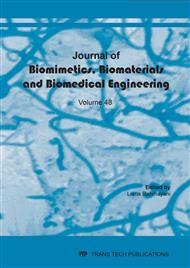[1]
Dalimartha S. Atlas Tumbuhan Obat Indonesia Jilid 2. Jakarta: Trubus Agriwidya; 2006. pp.12-16.
Google Scholar
[2]
Dutta M, Rej S, Jamal S, Das S, and Chatterjee S. Study of phytochemical constituents and antibacterial activity of Calotropis gigantea. International Science Journal 2014; 1(4):15-28.
Google Scholar
[3]
Suhaenah A. Pengaruh variasi konsentrasi cairan penyari etanol terhadap kadar polifenol pada daun Biduri (Calotropis gigantea L.). As-Syifaa International Journal 2016; 8(2):10-19.
DOI: 10.33096/jifa.v8i2.202
Google Scholar
[4]
Dewi DGDP, Mastra N, Jirna IN. Perbedaan zona hambat pertumbuhan Staphylococcus aureus pada berbagai konsentrasi ekstrak etanol daun Biduri Secara In Vitro. Meditory Journal 2018; 6(1):39-45.
DOI: 10.33992/m.v6i1.227
Google Scholar
[5]
Fuadiyah D, Ratnawaty R, Soebijakto BA. Pengaruh lama paparan LPS (Lipopolisakarida) Porphyromonas gingivalis sebagai induktor periodontitis terhadap kadar LDL dan HDL tikus wistar (Rattus norvegicus). E-Prodenta Journal Dentistry 2017; 1(2):54-67.
DOI: 10.21776/ub.eprodenta.2017.001.02.2
Google Scholar
[6]
Mahalakshmi K, Krhisnan P, Chandrasekaran SC, Panishankar KH, Subashini N. Prevalence of periodonphatic bacteria in the subgingiva plaque of a South Indian population with periodontitis. Journal of Clinical and Diagnosis Research 2012;6(4):747-752.
Google Scholar
[7]
Igboin CO, Griffen AL, Leys EJ. Porphyromonas gingivalis strain diversity. Journal of Clinical Biologi 2009; 47(10):3073-3081.
DOI: 10.1128/jcm.00569-09
Google Scholar
[8]
Azwanida NN. A Review on the extraction methods use in medicinal plants, principle, strength and limitation. Medicinal & Aromatic Plants Journal 2015;4(1):1-6.
DOI: 10.4172/2167-0412.1000196
Google Scholar
[9]
Sidarta YO, Prasetyaningrum N, Fitriani D, et.al. White pepper extract (Piper nigrum L.) as antibacterial agent for Streptococcus mutans in vitro. IOSRJournal of Dental and Medical Sciences 2013;4(6):25-29.
DOI: 10.9790/0853-0462529
Google Scholar
[10]
Alibasyah et al. Potensi antibakteri ekstrak jahe (Zingiber officinale Roscoe) terhadap Porphyromonas gingivalis secara in vitro. J Syiah Kuala Dent Soe 2016;1(2):147-152.
Google Scholar
[11]
Lutpiatina L. Pewarnaan Gram untuk buffy coat untuk deteksi awal pasien bakteremia. Medical Laboratory Technology Journal 2015;1(1):38-46.
DOI: 10.31964/mltj.v1i1.15
Google Scholar
[12]
Pelczar dan Chan. Dasar-Dasar Mikrobiologi. Diterjemahkan dari Elements Of Microbiology oleh Hadioetomo RS, dkk. Jakarta:UI Press;2005. pp.234-247.
Google Scholar
[13]
Klancnik A, Piskernik S, Jersek B, Mozina SS. Evaluation of diffusion and dilution methods to determine the antibacterial activity of plant extracts. Journal of Microbiological Methods 2010; 8(1):121-126.
DOI: 10.1016/j.mimet.2010.02.004
Google Scholar
[14]
Andrews JM. Determination of minimum inhibitory concentrations. Antimicrobial Chemother Journal 2002;49(6):1049-1060.
Google Scholar
[15]
Parija, Chandra. Textbook of Microbiology and Immunology. India: Elsevier; 2009. pp.135-137.
Google Scholar
[16]
Patil A, Mahale S, Joshi C, Karde P, Vaidya P. Honey as a potential Antimicrobial agent against P. gingivalis. International Journal of Contemporary Medical Research 2016; 3(9):2697-2700.
Google Scholar
[17]
Kanan M. Daya Antibakteri ekstrak daun Biduri (Calotropis gigantea Dryand.) terhadap bakteri Salmonella typhi secara in vitro. Jurnal Media Eksakta 2006;2(2):1-11.
Google Scholar
[18]
Suppakul P, Miltz J, Sonneveld K, Bigger SW. Active packaging technologies with an emphasis on antimicrobial packaging and its application. Journal of Food Science 2003; 68(2): 408-420.
DOI: 10.1111/j.1365-2621.2003.tb05687.x
Google Scholar
[19]
Saraswati D. Pengaruh konsentrasi ekstrak daun Sirih terhadap daya hambat Escherichia coli. Jurnal Health & Sport 2011;3(2)285-362.
DOI: 10.25077/jka.v4i2.265
Google Scholar
[20]
Fatisa, Y. DAYA ANTIBAKTERI ESTRAK KULIT DAN BIJI BUAH PULASAN (Nephelium mutabile) TERHADAP Staphylococcus aureus dan Escherichia coli SECARA IN VITRO. 10, (2013).
DOI: 10.25077/jka.v5i1.479
Google Scholar
[21]
Lamothe RG, Mitchell G, Gattuso M, Diarra MS. Plant antimicrobial agents and their effects on plant and human pathogens. International Journal of Molecular Sciences 2009;10(1): 3400-3.
DOI: 10.3390/ijms10083400
Google Scholar
[22]
Sharma, M. et al. Evaluation of antibacterial activity of Calotropis gigentica against Streptococcus mutans and Lactobacillus acidophilus: An in vitro comparative study. J. Conserv. Dent.18, 457 (2015).
DOI: 10.4103/0972-0707.168809
Google Scholar


